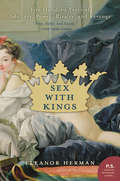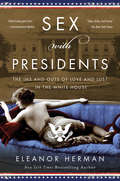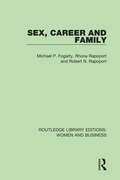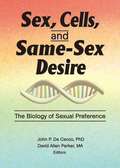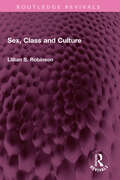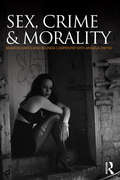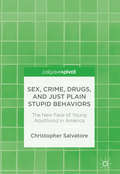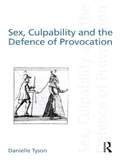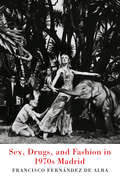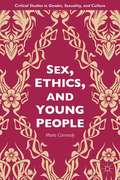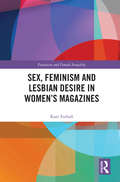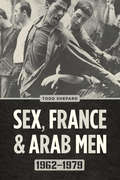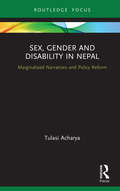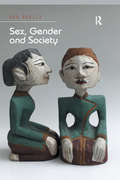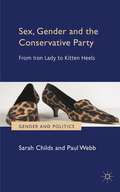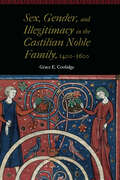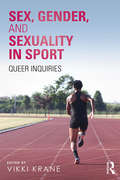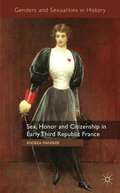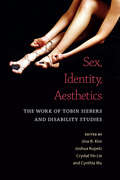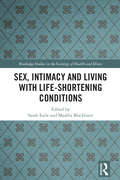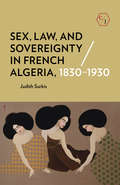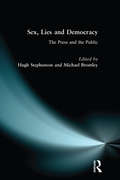- Table View
- List View
Sex with Kings: 500 Years of Adultery, Power, Rivalry, and Revenge (P. S. Ser.)
by Eleanor HermanThroughout the centuries, royal mistresses have been worshiped, feared, envied, and reviled. They set the fashions, encouraged the arts, and, in some cases, ruled nations. Eleanor Herman's Sex with Kings takes us into the throne rooms and bedrooms of Europe's most powerful monarchs. Alive with flamboyant characters, outrageous humor, and stirring poignancy, this glittering tale of passion and politics chronicles five hundred years of scintillating women and the kings who loved them. Curiously, the main function of a royal mistress was not to provide the king with sex but with companionship. Forced to marry repulsive foreign princesses, kings sought solace with women of their own choice. And what women they were! From Madame de Pompadour, the famous mistress of Louis XV, who kept her position for nineteen years despite her frigidity, to modern-day Camilla Parker-Bowles, who usurped none other than the glamorous Diana, Princess of Wales. The successful royal mistress made herself irreplaceable. She was ready to converse gaily with him when she was tired, make love until all hours when she was ill, and cater to his every whim. Wearing a mask of beaming delight over any and all discomforts, she was never to be exhausted, complaining, or grief-stricken. True, financial rewards for services rendered were of royal proportions -- some royal mistresses earned up to $200 million in titles, pensions, jewels, and palaces. Some kings allowed their mistresses to exercise unlimited political power. But for all its grandeur, a royal court was a scorpion's nest of insatiable greed, unquenchable lust, and vicious ambition. Hundreds of beautiful women vied to unseat the royal mistress. Many would suffer the slings and arrows of negative public opinion, some met with tragic ends and were pensioned off to make room for younger women. But the royal mistress often had the last laugh, as she lived well and richly off the fruits of her "sins." From the dawn of time, power has been a mighty aphrodisiac. With diaries, personal letters, and diplomatic dispatches, Eleanor Herman's trailblazing research reveals the dynamics of sex and power, rivalry and revenge, at the most brilliant courts of Europe. Wickedly witty and endlessly entertaining, Sex with Kings is a chapter of women's history that has remained unwritten -- until now.
Sex with Presidents: The Ins and Outs of Love and Lust in the White House
by Eleanor HermanIn this fascinating work of popular history, the New York Times bestselling author of Sex with Kings and The Royal Art of Poison uncovers the bedroom secrets of American presidents and explores the surprising ways voters have reacted to their leaders’ sex scandals.While Americans have a reputation for being strait-laced, many of the nation’s leaders have been anything but puritanical. Alexander Hamilton had a steamy affair with a blackmailing prostitute. John F. Kennedy swam nude with female staff in the White House swimming pool. Is it possible the qualities needed to run for president—narcissism, a thirst for power, a desire for importance—go hand in hand with a tendency to sexual misdoing?In this entertaining and eye-opening book, Eleanor Herman revisits some of the sex scandals that have rocked the nation's capital and shocked the public, while asking the provocative questions: does rampant adultery show a lack of character or the stamina needed to run the country? Or perhaps both? While Americans have judged their leaders' affairs harshly compared to other nations, did they mostly just hate being lied to? And do they now clearly care more about issues other than a politician’s sex life?What is sex like with the most powerful man in the world? Is it better than with your average Joe? And when America finally elects a female president, will she, too, have sexual escapades in the Oval Office?
Sex, Career and Family (Routledge Library Editions: Women and Business #6)
by Rhona Rapoport Robert N. Rapoport Michael P. FogartyIn this book, first published in 1971, the authors show from first-hand studies of family and working life (and with evidence from many countries, including the socialist societies of Eastern Europe) the nature of the discrimination facing women in the professions – and how various family and employment patterns might contribute to solving it. Their point is not that some new stereotype should be substituted for traditional views of the role of husbands and wives: different patterns fit different situations.
Sex, Cells, and Same-Sex Desire: The Biology of Sexual Preference
by David A ParkerThis fascinating new book explores the myriad aspects of biological theories of sexual preference. Sex, Cells, and Same-Sex Desire describes, reviews, and questions recent biological research on sexual preference from the point of view of knowledgeable scientists and of scholars in the social sciences and humanities representing the emerging field of gay studies. The issues involved have a vibrant history, are wide-ranging, and remain the objects of much controversy. This book demystifies biological research on sexual preference and makes it accessible to readers unfamiliar with biological and medical research.Sex, Cells, and Same-Sex Desire is divided into several sections, each of which is introduced by an explanation of key concepts and terms found in that section. The book begins with a discussion of the history of biological theories and sociocultural concepts of gender and sexuality. The next 3 sections explore specialized areas of biological science and related issues: genetics and evaluation, hormones and the endocrine system, and brain physiology and structure. A final section discusses social stigma, science, and medicine. A glossary of terms used by the authors is included, so readers may look up those that may be unfamiliar.
Sex, Class and Culture (Routledge Revivals)
by Lillian RobinsonFirst published in 1986, Sex, Class and Culture is a collection of Marxist feminist essays that develops an original critical theory and applies it to literature, the visual arts, and mass media. Lillian Robinson was the first American critic to suggest the essential connections among sex, class, and race as forces that shape works of art and the critical response to them. In applying her theory to particular texts, she considers topics from the Renaissance epic to the Regency romance, from Jane Austen to contemporary feminist poets, and from factory workers’ memoirs to TV images of career women and housewives. The essays are insightful because Robinson clearly knows this wide assortment of texts, cares about their significance, and writes about them with wit. They are irreverent, because she asserts the feminist critic’s permanent responsibility to ask "So What?" and they are controversial because she constantly addresses that question to our most powerful and respectable institutions – social and literary. This book will be of interest to students of literature, history, gender studies and sexuality studies.
Sex, Crime and Morality
by Sharon Hayes Belinda Carpenter Angela DwyerOver the last few decades, there has been a marked increase in media and debate surrounding a specific group of offences in modern Democratic nations which bear the brunt of the label ‘crimes against morality’. Included within this group are offences related to prostitution and pornography, homosexuality and incest and child sexual abuse. This book examines the nexus between sex, crime and morality from a theoretical perspective. This is the first academic text to offer an examination and analysis of the philosophical underpinnings of sex-related crimes and social attitudes towards them and the historical, anthropological and moral reasons for differentiating these crimes in contemporary western culture. The book is divided into three sections corresponding to three theoretical frameworks: Part 1 examines the moral temporality of sex and taboo as a foundation for legislation governing sex crimes Part 2 focuses on the geography of sex and deviance, specifically notions of public morality and the public private divide Part 3 examines the moral economy of sex and harm, including the social construction of harm. Sex, Crime and Morality will be key reading for students of criminology, criminal justice, gender studies and ethics, and will also be of interest to justice professionals.
Sex, Crime, Drugs, and Just Plain Stupid Behaviors: The New Face of Young Adulthood in America
by Christopher SalvatoreSex, Crime, Drugs, and Just Plain Stupid Behaviors: The New Face of Young Adulthood in America is written for students, parents, and practitioners to provide insight into how emerging adulthood impacts the lives and behaviors of young people. Salvatore provides an insightful examination of the evolution of emerging adulthood as a distinct stage of the life course, bridging the gap between macro-level social forces and micro-level life experiences and behavior. Chapters discuss the influence of social institutions such as marriage, the family, religion, and parenting on behavior during emerging adulthood. Exploration and sensation-seeking are examined in relation to the behaviors and identity of emerging adults alongside issues such as criminal offending, substance use, and other risky/dangerous behaviors. Finally, the book concludes with informed policy recommendations for social institutions such as educational establishments and the criminal justice system on how to work with emerging adults.
Sex, Culpability and the Defence of Provocation
by Danielle TysonThe partial defence of provocation is one of the most controversial doctrines within the criminal law. It has now been abolished in a number of international jurisdictions. Addressing the trajectory of debates about reform of the provocation defence across different jurisdictions, Sex, Culpability and the Defence of Provocation considers the construction and representation of subjectivity and sexual difference in legal narrations of intimate partner homicide. Undeniably, the most vexing exculpatory cultural narrative of our times is that of a woman 'asking for it'. This book explores how the process of judgment in a criminal trial involves not only the drawing of inferences from the facts of a particular case, but also operates to deliver a narrative. Law, it is argued, constructs a narrative of how the female body incites male violence. And, pursuing an approach that is informed by socio-legal studies, literary theory and feminist theories of the body, Sex, Culpability and the Defence of Provocation considers how this narrative is constructed via a range of discursive practices that position woman as a threat to masculine norms of propriety and autonomy. Once we have a clear understanding of the significance of narrative in legal decision-making, we can then formulate textual strategies of resistance to the violence of law's victim-blaming narratives by rewriting them.
Sex, Drugs, and Cocoa Puffs: A Low Culture Manifesto (Chuck Klosterman On Media And Culture Ser.)
by Chuck KlostermanFrom the author of the highly acclaimed heavy metal memoir, Fargo Rock City, comes another hilarious and discerning take on massively popular culture--set in Chuck Klosterman's den and your own--covering everything from the effect of John Cusack flicks to the crucial role of breakfast cereal to the awesome power of the Dixie Chicks.Countless writers and artists have spoken for a generation, but no one has done it quite like Chuck Klosterman. With an exhaustive knowledge of popular culture and an almost effortless ability to spin brilliant prose out of unlikely subject matter, Klosterman attacks the entire spectrum of postmodern America: reality TV, Internet porn, Pamela Anderson, literary Jesus freaks, and the real difference between apples and oranges (of which there is none). And don't even get him started on his love life and the whole Harry-Met-Sally situation. Whether deconstructing Saved by the Bell episodes or the artistic legacy of Billy Joel, the symbolic importance of The Empire Strikes Back or the Celtics/Lakers rivalry, Chuck will make you think, he'll make you laugh, and he'll drive you insane--usually all at once. Sex, Drugs, and Cocoa Puffs is ostensibly about art, entertainment, infotainment, sports, politics, and kittens, but--really--it's about us. All of us. As Klosterman realizes late at night, in the moment before he falls asleep, "In and of itself, nothing really matters. What matters is that nothing is ever 'in and of itself.'" Read to believe.
Sex, Drugs, and Fashion in 1970s Madrid (Toronto Iberic)
by Francisco Fernandez de AlbaDuring the last decade of Franco’s repressive rule, the Spanish outlook on sex, drugs, and fashion shifted dramatically, creating a favorable cultural environment for the return of democracy. Exploring changes in urban planning, narratives of sexual and gender identity, recreational drug use, and fashion design during the seventies, Sex, Drugs, and Fashion in 1970s Madrid argues that it was during this decade that the material and emotional conditions for the groundbreaking transition to democracy first began to develop. Thanks in part to a mass media saturated with international trends, citizens of Madrid began to adopt practices, behaviors, and attitudes that would ultimately render Franco’s military dictatorship obsolete. This cultural history examines these modest but irreversible changes in the way people lived and thought about their lives during the last decade of the regime’s creed. Not a revolution necessarily, but transformational nevertheless, these changes in collective sensibility eased the political transition to democracy and the emergence of the eighties’ cultural movement la Movida.
Sex, Economy, Freedom and Community: Eight Essays
by Wendell BerryIn this new collection of essays, Wendell Berry continues his work as one of America's most necessary social commentators. With wisdom and clear, ringing prose, he tackles head-on some of the most difficult problems which face us as we near the end of the twentieth century. Berry begins the title essay with the Anita Hill-Clarence Thomas hearings as an example of a "process that has been well established and well respected for at least two hundred years--the process . . . of community disintegration. " Community, a "locally understood interdependence of local people, local culture, local economy, and local nature," bound by trust and affection, is "being destroyed by the desires and ambitions of both private and public life which for want of the intervention of community interests, are also destroying one another. " He then moves on to elucidate connections between sexual brutality and economic brutality, and the role of art and free speech. Berry forcefully addresses America's unabashed pursuit of self-liberation, which he says is "still the strongest force now operating in our society. " As individuals turn away from their community, they conform to a "rootless and placeless monoculture of commercial expectations and products," buying into the very economic system which is destroying the earth, our communities, and all they represent. Throughout the book Berry asks, What is appropriate? What is worth conserving from our past and preserving in our present? What is it to be human and truly connected to others? What does it mean to be free?
Sex, Ethics, and Young People
by Moira CarmodySex, Ethics, and Young People explores how young people determine their expectations from a sexual relationship. Bringing together research and education on sexuality and sexual assault prevention, Carmody explains how the six week skill-based Sex & Ethics program, based in Australia and New Zealand, can provide a curriculum of sexual education, and the skills needed by educators to run the program successfully. Research conducted with men and women enrolled in the program demonstrate how a focus on the education of sexuality, sexual ethics, and violence prevention can have a lasting impact on young people developing ethical sexual relationships.
Sex, Feminism and Lesbian Desire in Women’s Magazines (Feminism and Female Sexuality)
by Kate FarhallThis book examines evolving pop culture representations of sex and relationships from the 1970s onwards, to demonstrate parallels between the strength of the feminist movement and positive portrayals of women’s sexuality. In charting changes in the sex and relationship content of women’s magazines over time, this analysis reveals that despite surface-level changes in sexual and relationship content, the underlying paradigm of hetero-monogamy remains unchanged. Despite a seemingly more diverse, empowered and liberated sexuality for women in contemporary magazines, in reality, such feminist rhetoric masks an enduring model of sexuality, which rests on women’s sexual and emotional maintenance of male partners and their own self-objectification and self-surveillance. Where substantive changes can be identified, they rise and fall in tandem with feminism. By demonstrating this empirical relationship between cultural products and feminist organising, the book validates an assumption that has rarely been tested: that a feminist social milieu improves cultural narratives about sexuality for women. Sex, Feminism and Lesbian Desire builds on ground-breaking feminist texts such as Susan Faludi’s Backlash to present an empirically focused, comprehensive study interrogating changes in content over the lifetime of women’s magazines. By charting the representation of sex and relationships in two women’s magazines—Cosmopolitan and Cleo—since the 1970s through an analysis of over 6,500 magazine pages and 1,500 articles, this timely work interrogates—and ultimately complicates—the apparent linear progression of feminism. This book is suitable for researchers and students in women’s and gender studies, queer studies, LGBT studies, media studies, cultural studies and sociology.
Sex, France, and Arab Men, 1962–1979
by Todd ShepardThe aftermath of Algeria’s revolutionary war for independence coincided with the sexual revolution in France, and in this book Todd Shepard argues that these two movements are inextricably linked.?Sex, France, and Arab Men is a history of how and why—from the upheavals of French Algeria in 1962 through the 1970s—highly sexualized claims about Arabs were omnipresent in important public French discussions, both those that dealt with sex and those that spoke of Arabs. Shepard explores how the so-called sexual revolution took shape in a France profoundly influenced by the ongoing effects of the Algerian revolution. Shepard’s analysis of both events alongside one another provides a frame that renders visible the ways that the fight for sexual liberation, usually explained as an American and European invention, developed out of the worldwide anticolonial movement of the mid-twentieth century.
Sex, Gender and Disability in Nepal: Marginalized Narratives and Policy Reform (Routledge ISS Gender, Sexuality and Development Studies)
by Tulasi AcharyaThis book explores the sex lives of women with disabilities in Nepal, showing that many women suffer more than men despite prevailing disability policies that emphasize nondiscrimination against people with disabilities. It also argues that far from general perceptions of women as asexual, women with disabilities are capable of leading highly creative and fulfilling sexual lives. Using critical sexual theory and postcolonial studies as critical frameworks, the book investigates the narratives of authors with disabilities, exploring policy gaps and the need for supportive gender and sexual policies through the words of those affected. In particular, the book analyzes five female Nepali authors with disabilities: Radhika Dahal, Jhamak Ghimire, Sabitri Karki, Parijaat, and Mira Sahi, demonstrating the need for supportive gender policies to address the emotional and psychological needs of women with disabilities. Overall, the book argues that disciplinary discourses in practice often consider sex or sexuality as taboo, barely recognizing women in the context of marriage and family, and therefore creating gaps between policies and marginalized narratives. This book provides important insights into sex and disability within the context of the Global South, and as such will be of interest not only to researchers working on Nepal but also to scholars across gender studies, disability studies, international development, and postcolonialism.
Sex, Gender and Society
by Ann OakleyWhat are the differences between the sexes? That is the question that Ann Oakley set out to answer in this pioneering study, now established as a classic in the field. To answer it she draws on the evidence of biology, anthropology, sociology and the study of animal behaviour to cut through popular myths and reach the underlying truth. She demonstrates conclusively that men and women are not two separate groups: rather each individual takes his or her place on a continuous scale. She shows how different societies define masculinity and femininity in different and even opposite ways, and discusses how far observable differences are based on biology and psychology and how far on cultural conditioning. Many books have discussed these vital issues. None, however, have drawn on such an impressively wide range of evidence or discussed it with such clarity and authority. Now newly reissued with a substantial introduction which highlights its continuing relevance, this work will continue to inform and shape dialogues around sex and gender for a new generation of scholars and students.
Sex, Gender and the Conservative Party
by Sarah Childs Paul WebbAs leader of the Conservative party, David Cameron inherited a multi-faceted gender problem: only 17 women MPs; an unhappy women's organization; electorally uncompetitive policies 'for women'; and a party which was seemingly unattractive to women voters. This book is an account of the feminization of the party since 2005.
Sex, Gender, and Illegitimacy in the Castilian Noble Family, 1400–1600 (Women and Gender in the Early Modern World)
by Grace E. CoolidgeSex, Gender, and Illegitimacy in the Castilian Noble Family, 1400–1600 looks at illegitimacy across the fifteenth and sixteenth centuries and analyzes its implications for gender and family structure in the Spanish nobility, a class whose actions, structure, and power had immense implications for the future of the country and empire. Grace E. Coolidge demonstrates that women and men were able to challenge traditional honor codes, repair damaged reputations, and manipulate ideals of marriage and sexuality to encompass extramarital sexuality and the nearly constant presence of illegitimate children. This flexibility and creativity in their sexual lives enabled members of the nobility to repair, strengthen, and maintain their otherwise fragile concept of dynasty and lineage, using illegitimate children and their mothers to successfully project the noble dynasty into the future—even in an age of rampant infant mortality that contributed to the frequent absence of male heirs. While benefiting the nobility as a whole, the presence of illegitimate children could also be disruptive to the inheritance process, and the entire system privileged noblemen and their aims and goals over the lives of women and children. This book enriches our understanding of the complex households and families of the Spanish nobility, challenging traditional images of a strict patriarchal system by uncovering the hidden lives that made that system function.
Sex, Gender, and Sexuality in Sport: Queer Inquiries
by Vikki KraneDiverse sex, gender, and sexual identities historically have been pushed to the margins in sport. While there is more visibility and inclusion for LGBTIQ (lesbian, gay, bisexual, transgender, intersex, queer) people in sport today than in the past, there still exists bigotry and marginalization. In this book, Vikki Krane and a team of leading sport scholars critically assess what we know about sex, gender, and sexuality in sport; expose areas in need of further inquiry; and offer new avenues for theory, research, and practice. Drawing on cultural studies perspectives, and with social justice at the heart of every chapter, the book discusses theory, policy, practice, and the experiences of LGBTIQ people in sport. Sex, Gender, and Sexuality in Sport is an important read for undergraduate and postgraduate students in any class with content on LGBTIQ people in sport, but particularly for those studying sport and gender, sexuality and sport, LGBT studies, psychology of gender, contemporary issues in sport, sociology of gender, and sport and higher education. It is also a vital resource for scholars who conduct research in the area of LGBTIQ people in sport.
Sex, Honor and Citizenship in Early Third Republic France
by Andrea ManskerA repositioning of French women's struggle for suffrage within the distinct cultural landscape of the masculine honour system. Whether activists demanded admission to the popular ritual of the duel or publicly shamed men for their extramarital sexual behaviour, they appropriated extralegal honour codes to enact new civic and familial identities.
Sex, Identity, Aesthetics: The Work of Tobin Siebers and Disability Studies
by Joshua Kupetz Cynthia Wu Jina B. Kim Crystal Yin LieThe late Tobin Siebers was a pioneer of, and one of the most prominent thinkers in, the field of disability studies. His scholarship on sexual and intimate affiliations, the connections between structural location and coalitional politics, and the creative arts has shaped disability studies and continues to be widely cited. Sex, Identity, Aesthetics: The Work of Tobin Siebers and Disability Studies uses Siebers’ work as a launchpad for thinking about contemporary disability studies. The editors provide an overview of Siebers’ research to show how it has contributed to humanistic understandings of ability and disability along three key axes: sex, identity, and aesthetics. The first section of the book explores how disability provides a way for scholars to theorize a wider range of intimacies and relationalities, arguing that disabled people seek sexual access and revolution in ways that transgress heteronormative dictates on sexual propriety. The second part of the book works outward from Siebers’ work to looks at how disability broadens our concepts of social location and political affiliations. The final section examines how disability challenges traditional notions of artistic beauty and agency. Rather than being a strictly commemorative collection meant to mark the end of a major scholar’s career, this collection shows how Siebers’ foundational work in disability studies remains central to and continues to inspire scholars in the field today.
Sex, Intimacy and Living with Life-Shortening Conditions
by Sarah Earle Maddie BlackburnThis multi-disciplinary and inclusive collection brings together theoretically informed and empirically focused research on sex, intimacy and reproduction in relation to young people and adults with life-shortening conditions. Advances in healthcare mean that increasing numbers of young people with life-shortening conditions are transitioning into adulthood. Issues such as sex and intimacy, dating and relationships, fertility and having children are increasingly relevant to them and to the people that support them, including families, carers, practitioners and professional education, health and social care agencies. This three-part book explores the relevance and significance of this field, examines everyday experiences, and highlights the challenges faced by individuals and organisations in addressing the needs of such people in daily life and in the context of practice. Drawing on perspectives from sociology, disability studies, epidemiology, health policy, psychotherapy, legal studies, queer studies and nursing, this ground-breaking volume is written by academics, policy makers, practitioners and experts by experience. It is an essential read for all those practising and researching in the fields of sexuality, chronic illness and disability and transition.
Sex, Law, and Sovereignty in French Algeria, 1830–1930 (Corpus Juris: The Humanities in Politics and Law)
by Judith SurkisDuring more than a century of colonial rule over Algeria, the French state shaped and reshaped the meaning and practice of Muslim law by regulating it and circumscribing it to the domain of family law, while applying the French Civil Code to appropriate the property of Algerians. In Sex, Law, and Sovereignty in French Algeria, 1830–1930, Judith Surkis traces how colonial authorities constructed Muslim legal difference and used it to deny Algerian Muslims full citizenship. In disconnecting Muslim law from property rights, French officials increasingly attached it to the bodies, beliefs, and personhood.Surkis argues that powerful affective attachments to the intimate life of the family and fantasies about Algerian women and the sexual prerogatives of Muslim men, supposedly codified in the practices of polygamy and child marriage, shaped French theories and regulatory practices of Muslim law in fundamental and lasting ways. Women's legal status in particular came to represent the dense relationship between sex and sovereignty in the colony. This book also highlights the ways in which Algerians interacted with and responded to colonial law. Ultimately, this sweeping legal genealogy of French Algeria elucidates how "the Muslim question" in France became—and remains—a question of sex.
Sex, Lies and Democracy: The Press and the Public
by Michael Bromley Hugh StephensonDo the Press have a case for asserting their right and moral obligation to call figures in the public eye to account? Or is it time for the government to abandon the Press Complaints Commission and introduce some legislation to deal with the problem? Is there really a problem?The question of the accountability and regulation of the Press has become a central theme of contemporary life and is the focus of this new book.
Sex, Lies, and Handwriting: A Top Expert Reveals the Secrets Hidden in Your Handwriting
by Michelle Dresbold James KwalwasserHave you ever looked at someone and thought: He looks honest. She seems friendly. He doesn't look like a serial killer. Are you always right? Looks can be deceiving, but handwriting never lies. Handwriting profiling is an amazingly accurate tool for assessing how people think, feel, and act. In fact, handwriting profiling is so accurate that the FBI, the CIA, and the Israeli intelligence agency Mossad use it to build detailed psychological profiles of some of the world's most dangerous individuals. And thousands of major corporations use handwriting profiling to help them make the right hiring decisions. Handwriting expert Michelle Dresbold -- the only civilian to be invited to the United States Secret Service's Advanced Document Examination training program -- draws on her extensive experience helping law enforcement agencies around the country on cases involving kidnapping, arson, forgery, murder, embezzlement, and stalking to take us inside the mysterious world of crossed t's and dotted i's. In Sex, Lies, and Handwriting, Dresbold explains how a single sentence can provide insight into a person's background, psychology, and behavior. Throughout the book, Dresbold explores the handwriting of sly politicians, convicted criminals, notorious killers, suspected cheats, and ordinary people who've written to Dresbold's "The Handwriting Doctor" column for help. She shows you how to identify the signs of a dirty rotten scoundrel and a lying, cheating, backstabbing lover. And she introduces you to some of the most dangerous traits in handwriting, including weapon-shaped letters, "shark's teeth," "club strokes," and "felon's claws." (When you see these traits in someone's script, she says, "it's time to stop reading and start running!") Dresbold also explains how criminals are tracked through handwritten clues and what spouses, friends, or employees might be hiding in their script. Finally, Dresbold re-examines the handwriting evidence in several notorious unsolved cases. She uncovers fascinating clues that reveal the secret side of Lizzie Borden, acquitted of the ax murder of her parents in 1893's "trial of the century." Dresbold also reveals astonishing details about the author of the JonBenÉt Ramsey ransom note, and she presents startling new evidence that exposes the real Jack the Ripper (contrary to popular theories, he wasn't a prince or a painter after all). Sex, Lies, and Handwriting will have you paying a bit more attention to your -- and everyone else's -- penmanship.
